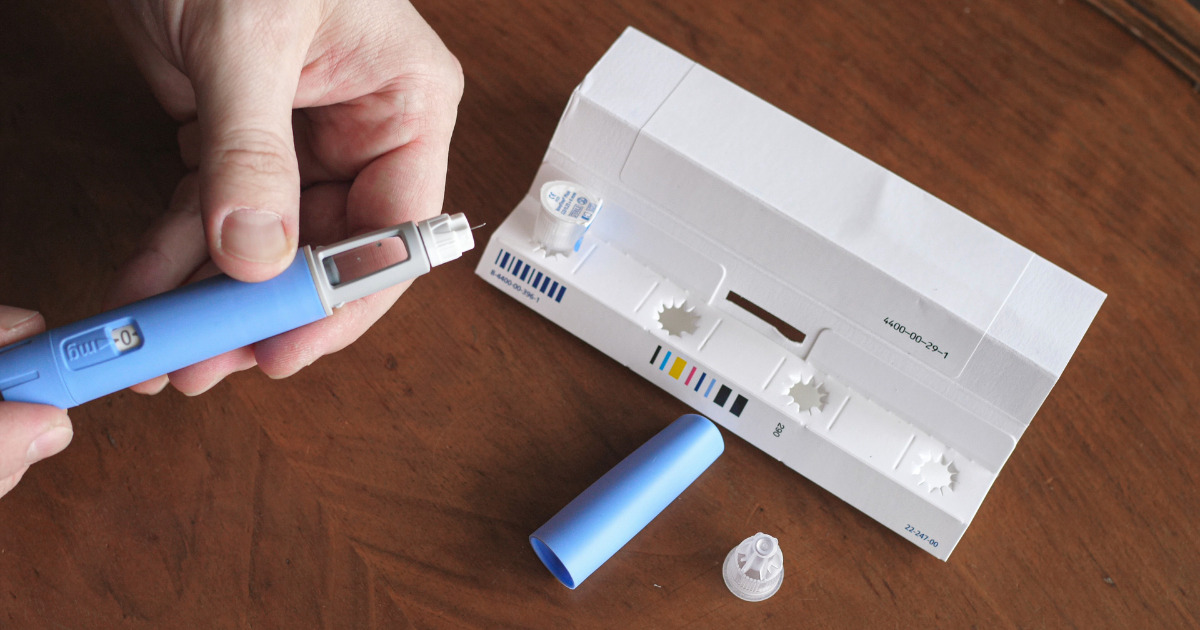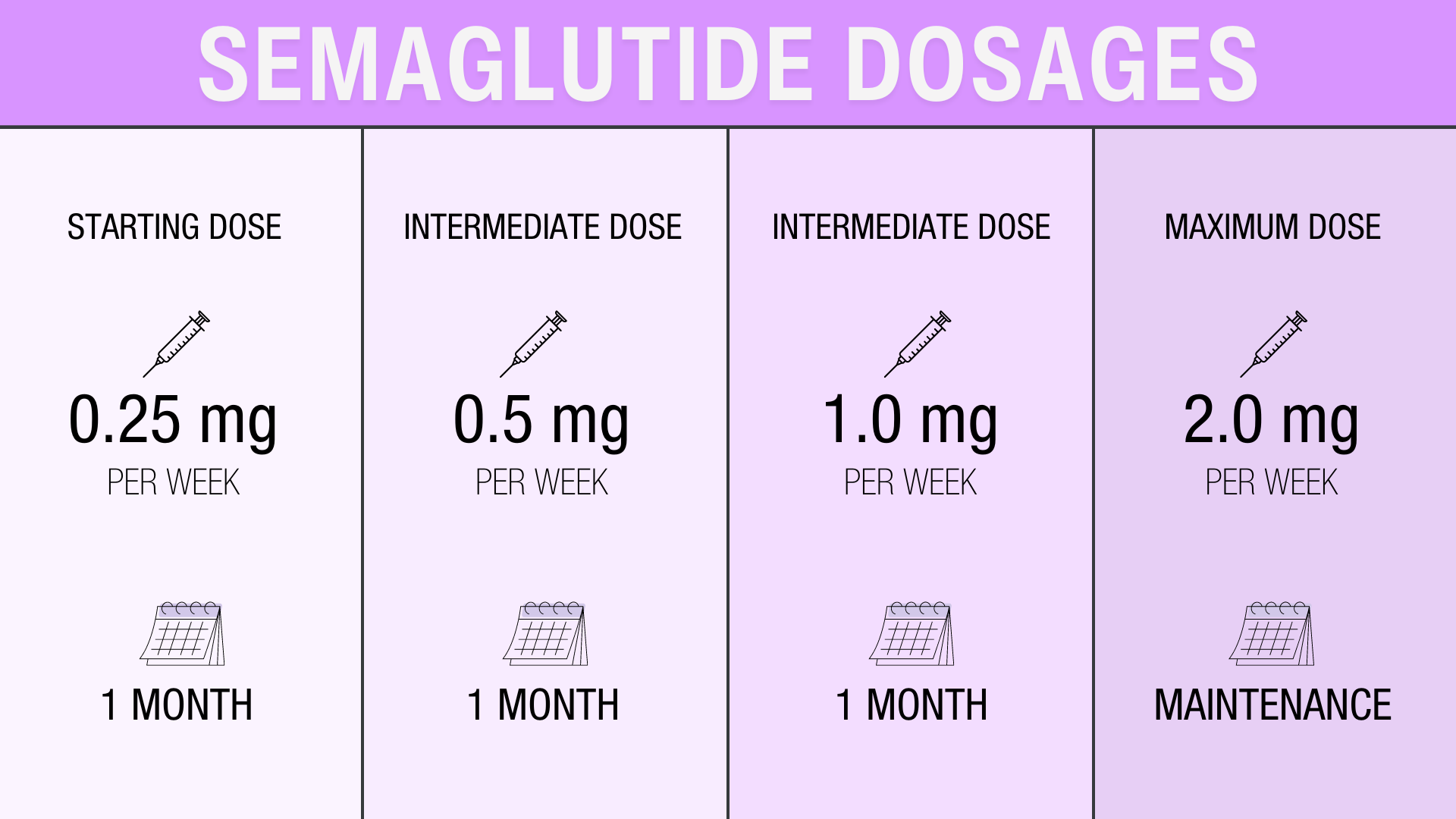
Semaglutide Weight Loss Dosage Chart: What to Expect During Your Weight Loss Journey
Are you thinking about taking Semaglutide injections to drop excess pounds? If so, it’s important to review the typical Semaglutide weight loss dosage chart so you know how your treatments will work. Most people begin treatment with the same low dosage and slowly work their way up to a dosage that works well for them. This may be the maximum recommended dosage or something a bit lower, depending on each person’s weight loss goals and tolerance to the drug.
Semaglutide belongs to a class of drugs called GLP-1 agonists. These drugs work similarly to natural hormones found within the gut that control cravings and hunger, slow digestion, and prevent overeating. Semaglutide has helped millions of people lose excess pounds, even after other interventions didn’t work. Will you be next to benefit from this remarkable weight loss aid? Here’s what you should know about the typical Semaglutide weight loss dosage chart and what to expect during your weight loss journey.
How Semaglutide Helps You Lose Weight

Losing weight can feel like a complicated dance to which you don’t know the steps. It’s much more complex than the simplistic “calories in vs. calories out” mantra that’s still chanted by many weight loss gurus and health professionals today. Some people face an uphill battle against weight loss due to genetics, medical conditions, medications, and other factors outside of their control. The Food and Drug Administration recognizes this. That’s why they’ve approved cutting-edge weight loss medications to help target some of the main causes of obesity and excess weight.
Semaglutide began as a treatment for type 2 diabetes. It stimulates the pancreas to release more insulin, which improves blood sugar levels. But it soon became apparent that the drug had incredible weight-loss benefits, as well. In 2021, the FDA approved once-weekly Semaglutide injections for weight loss in adults. Providers recommend patients follow a Semaglutide for weight loss dosage chart, which starts with a low dose and slowly increases to a more effective dose. The drug is making huge waves in the weight loss industry because of its effectiveness.
There are many reasons people struggle to lose excess weight. In some cases, genetics predispose certain people to rapid weight gain and retention. In other cases, uncontrollable cravings for unhealthy, calorie-dense foods can drive people to eat too many calories for their body’s energy needs. Semaglutide makes it easier to consume fewer calories by reducing cravings. It also slows the body’s digestion rate, which helps patients feel fuller longer. Finally, Semaglutide reduces spikes in blood sugar levels, which further helps control appetite.
What to Expect During Your Semaglutide Weight Loss Journey

If you’re getting ready to begin Semaglutide treatments, you probably have a lot of questions. It’s best to talk with your provider about those questions so you know exactly what to expect. But you can also do your own research to learn how the drug works, what side effects you might experience, and how the typical Semaglutide dosage chart works.
Semaglutide Weight Loss Dosage Chart in Units

Not everyone follows the same Semaglutide dosage schedule. Some people choose to stay on a low dose of Semaglutide indefinitely to mitigate side effects. Others may prefer to reach the maximum dosage as fast as possible so they can enjoy optimal weight loss benefits. Though everyone is different, here is the Semaglutide dosage chart experts recommend for most people.
Starting Dose
Experts recommend a Semaglutide starting dosage of just 0.25 mg per week. You should remain at this dosage for a month or longer so your body can adjust to the medication. This isn’t an effective dose, but it’s necessary to start here if you want to minimize any side effects you may experience. At 0.25 mg per week, Semaglutide can’t regulate your blood sugar levels and likely won’t result in meaningful weight loss. However, as you continue to follow the Semaglutide weight loss dosage chart through its recommended increases, you will eventually see changes on the scale.


Intermediate Doses
After a month at the starting dose, your provider may increase your dosage to 0.5 mg of Semaglutide per week. However, if you’re experiencing unwanted symptoms on the lowest dose, they may keep you at that dose for a while longer. When you’re able to move up to a 0.5 mg dose, your provider will keep you at that dose for another month or longer.
If your body acclimates well to the 0.5 mg dose for at least a month, you may get the go-ahead to begin receiving 1.0 mg of Semaglutide per week. This dosage provides additional glycemic control. It’s also the maximum amount recommended for periodic maintenance treatments.
Intermediate Doses
After a month at the starting dose, your provider may increase your dosage to 0.5 mg of Semaglutide per week. However, if you’re experiencing unwanted symptoms on the lowest dose, they may keep you at that dose for a while longer. When you’re able to move up to a 0.5 mg dose, your provider will keep you at that dose for another month or longer.
If your body acclimates well to the 0.5 mg dose for at least a month, you may get the go-ahead to begin receiving 1.0 mg of Semaglutide per week. This dosage provides additional glycemic control. It’s also the maximum amount recommended for periodic maintenance treatments.

Maximum Dose
In some cases, people who reach the maximum recommended amount of 1.0 mg of Semaglutide per week don’t get the results they want. They may not achieve adequate glycemic control or lose weight as expected. If this happens to you, talk to your provider about adjusting your Semaglutide weight loss dosage chart. They may decide to boost your dose up to 2.0 mg of Semaglutide per week. This is the maximum allowable dose and should result in noticeable weight loss as well as improved blood sugar levels.

Dosage-Influencing Factors
No two individuals respond to medication the same way. That’s why there will never be a one-size-fits-all medication dosage chart that works 100% of the time. Here are some of the factors that can potentially influence your starting, maximum, and maintenance Semaglutide dosages:
-
Genetics: Things like body build and mass can impact how effective Semaglutide injections are for your body.
-
Sex: Your biological sex can influence how well you metabolize medication.
-
Disease: Some diseases reduce your body’s ability to absorb or excrete medications.
-
Age: Common physical problems associated with age can increase your likelihood of experiencing unwanted side effects from medications.
It’s important to start and continue your Semaglutide journey with help from a trusted professional. They’ll follow a Semaglutide weight loss dosage chart and monitor your progress. They’ll also give you recommendations for what you can do if you start to experience unwanted symptoms from your injections.
Who Should Not Receive Semaglutide?
Not everyone is a good candidate for Semaglutide injections. Your existing health can play a huge role in how you respond to the medication. In some cases, your health history could even disqualify you from this treatment. You should not receive Semaglutide injections if you have:
-
Thyroid cancer
-
Allergic reactions to Semaglutide or any of the components of the medication
-
Endocrine syndromes (such as Multiple Endocrine Neoplasia syndrome type 2)
Other health conditions increase your risk of complications while taking Semaglutide, but may not completely disqualify you from receiving this cutting-edge drug. If you have kidney impairment, diabetic retinopathy, or a history of pancreatitis, you must only take Semaglutide while being closely monitored by a professional. Women should not take Semaglutide while pregnant or breastfeeding.
Medical Supervision is the Key to a Successful GLP-1 Experience

Some people purchase Semaglutide online and inject it themselves without medical guidance or reference to Semaglutide weight loss dosage chart recommendations. This is a dangerous decision that could lead to an increased risk of side effects or dangerous health conditions.
Checking in regularly with a professional can help you meet your weight loss goals in the safest way possible. Your provider will monitor your health to ensure your organs aren’t being damaged by the drug. They’ll also identify potential issues and interactions before they cause serious problems.
It may be tempting to crank up your Semaglutide dosage on your own so you can get rapid weight loss results even faster. However, this is an extremely risky decision. It’s far better to follow your provider’s expert dosage recommendations. You should never be so desperate to lose weight quickly that you sacrifice your overall health to reach your goal.
Why You Should Follow the Semaglutide for Weight Loss Dosage Chart
Following a structured dosage plan also makes it easier to monitor your reactions to the medication and to make adjustments to your dose as needed. Common side effects of Semaglutide include:
-
Gastrointestinal disturbances
-
Nausea
-
Vomiting
-
Diarrhea
-
Fatigue
-
Constipation
-
Headache
If you want to minimize these types of symptoms, it’s important to follow recommended Semaglutide dosage charts. Some people still experience unpleasant side effects even after following dosage recommendations. However, symptoms usually subside gradually after the first few weeks of taking the medication.
Calista Skin & Laser Center is dedicated to ensuring out GLP-1 patients know how to navigate Semaglutide side effects, so they can enjoy their weight loss journey without post-injection woes.
Get a Customized Weight Loss Plan at Calista Skin & Laser Center
Following a tried-and-proven Semaglutide dosage chart for weight loss is usually a great idea. However, your body is unique, and so are your weight loss goals. That’s why it’s so important to receive personalized care when you embark on your medication-assisted weight loss journey. Calista Skin & Laser Center is a respected provider of customized Semaglutide weight loss injections. Call us today at 817-488-3838 to schedule a consultation and receive your treatment plan.
Schedule a consultation
Please fill out the form below or call us at 817-488-3838
By submitting this form you agree to be contacted via phone, text, and/or email.
Schedule a consultation
Please fill out the form below or call us at 817-488-3838
By submitting this form you agree to be contacted via phone, text, and/or email.
